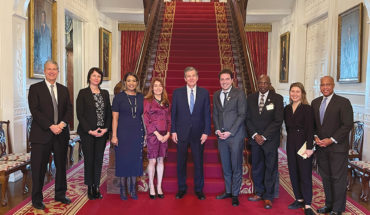
Clockwise from bottom left: actor and NC Theatre Conservatory artistic director Ray Walker, actor Lauren Kennedy, actor English Bernhardt,
producer Carolee Baxter, actor Clay Aiken, executive director Lisa Grele Barrie, actor Reed Shannon, founder De Ann Jones
by Andrew Kenney
photograph by Travis Long
Saturday night at Raleigh Memorial Auditorium in the 30th season of North Carolina Theatre is a formal affair. Heels and dress shoes click down Fayetteville Street toward the tall columns and glass walls of the theater. They’re here for Les Miserables – and for the theater group that literally cut a lock from the doors of this 1930s-era palace three decades ago and built a bridge to Broadway.
The lobby’s packed. Carolee Baxter, the show’s producer, stops for hugs with one patron and to explain that she couldn’t dig up tickets for another. Les Mis is deep in its run, but there’s always an opening-night sense of happening here.
Baxter cuts through the crowd, spinning between a few more couples and onto an unmarked side door. There are
quiet cinderblock halls, a darkened room where a stage tech sleeps in a huge prop wheelbarrow – and then there’s backstage.
It’s 30 minutes to curtain, and the back of the house is humming. New York actors in filthy-looking rags pace back and forth, muttering their lines, and local kids pop across the room wearing long blond tresses or French guards’ uniforms.
For the actors, it’s easy to forget that close to 2,000 people are waiting on the other side of the curtain. Just the same, the crowd’s missing part of the story too. The production is so grand – the set’s looming apartment blocks, the names in the program – that it seems like a Broadway company has stopped on tour.
This is a local group that came from almost nothing, that has grown and changed with the city, and that even now is stocked by characters with narratives of their own. Much of the talent is local and the productions are planned at the Duke Energy Center for the Performing Arts. The story behind the place has as many ups and downs – well, not quite – as the play that’s on tonight. North Carolina Theatre’s alive, and it’s an institution.
Actually, founder De Ann Jones, 75, winces at the mention of the word “institution.”
“Oh, I hate to hear that,” she says at the suggestion that her baby has become such a thing.
She’s sitting for an interview at a coffee shop in Cary. For an hour she has been dialing up stories of how her scrappy crew made do in the musical theater’s earlier years, ticking easily through the names and playbills of three decades’ work.
This word, though, sends her somewhere else. She looks off to the side, her silver bangles still for a second.
“I don’t hate that. It’s just – ah, the excitement of not knowing, the excitement of walking on the edge…”
Her mission at the beginning of the theater’s story was to make art downtown, where there wasn’t much. “After 5, they cut the lights out,” Jones says. Raleigh Memorial, built during the Depression, was largely unused by the ’80s, hosting the occasional high-school graduation and the symphony a few times a year.
Jones, in the early ’80s, was working with Theater in the Park, which had just debuted the now-traditional A Christmas Carol performance in Pullen Park. The city government, seeking a boost for downtown, asked Jones to “come downtown and do some
theater.”
The first sign of a tall order: No one could find the key to unlock the grand theater. Some apocryphal histories say Jones herself cut the lock, but she says a groundskeeper actually did the deed.
Inside she found a dusty theater with no backstage and inconvenient dressing rooms stashed away upstairs.
“But being adventurous, I guess, I said, ‘All right, we’ll try, but I want to do professional theater.’ ”
With little more than a building and some money, Jones convinced her friend Terrence Mann to come down. Mann was a North Carolina School of the Arts alum who had made a start on Broadway, the kind of person who was proof to theater kids of some higher plane of professional drama.
Mann wanted to be King Arthur in Camelot, and by May 1984, the show was ready to go. De Ann Jones had spent most of the theater’s budget by the last curtain call.
“The city gave me a $75,000 interest-free loan to start,” she says. “I spent it all on the first show. I was supposed to do three shows … By the time of West Side Story, I had not a dime.”
It was a hardscrabble stretch of a few years, with cramped offices and cleverly repurposed sets squeezed into the budget.
“Well, yeah, I’ve had a lot of fun, but I have also spent (all) night cutting costumes upstairs…in Memorial Auditorium,” she says. “I had lots of energy back then. I’d give anything for 15 minutes of it now.”
Her plan was big: to bring top-notch musical theater to Raleigh. Theater here was then the product of well-loved community outfits. For theater professionals, the local stage was a few yards too short.
“There was nowhere to go. You had to go to New York, and Chicago,” Jones says.
As the curtain rises on this recent Saturday night, the musical’s darkened Paris set with its finely detailed buildings looks like it has been painted into the air. Jean Valjean – played by Craig Schulman – takes the stage with a weighty grace that seems natural to the part.
In fact, Schulman has played Valjean more than 2,000 times, according to the performance program. Yet behind his name are the biographies of kids from Wake County who are only in their first dozen productions of anything. Because the theater itself produces and directs its shows, its organizers are free to draw in local actors, costume artists, technical directors, and more.
A spotlight beams from the back in an early scene, catching the character of Fantine. The actor, Lauren Kennedy, 40, is an alum of the theater’s earliest years, when she attended its prototype performing-arts school in Raleigh. Like so many of Jones’s and North Carolina Theatre’s protégés, she has come back to Raleigh.
The difference between those early years and now is that, increasingly, the talent flows both ways. More than a draw for New York talent, North Carolina Theatre and its conservatory have become a springboard for young local actors.
English Bernhardt, almost 18 on this night, sweeps onto the stage as Eponine, leaping from sonorous lows to glassy highs in a solo. She looks young and sure-footed on this stage, because she grew up on it. Now a senior at Ravenscroft School, she looks to the show’s veteran actors for advice about a performer’s life.
“I have a huge decision in my life in terms of next year,” she says. “Some people say go to college, go to New York, don’t go for musical theater… They have all kind of taken different paths. Working with the people that come from New York – they have honestly shaped who I am as a performer.”
Clay Aiken, the singer and current Congressional candidate, says North Carolina Theatre introduced him to performance. A nosebleed view of Martin Moran performing in Big River when Aiken was 13 “was probably the first time that I’d ever realized that you could make a living singing. That was kind of powerful to me,” he says. And his years performing with the theater, he says, gave him connections for the rest of his career.
Reed Shannon, the 13-year-old actor who plays the character Gavroche, has already made his first leap out of Raleigh, traveling with his father to Chicago just weeks after Les Mis ended in order to take another stage.
The boy who used to watch from the doorway as his sister sang and danced through North Carolina Theatre Conservatory classes is set to play a young Michael Jackson in the traveling production of Motown: The Musical.
“It’s going to be hard for me to leave,” he says.
Real world
There’s no doubt by the end of Les Mis that there will be a standing ovation. The crowd roars for the old-hand stars, and they’re louder for the hometown kids.
Just as carefully as these people have watched the stage, the theater is watching them – and their entertainment habits. North Carolina Theatre has seen its patrons distracted by new entertainment offerings, including the massively popular, newer touring shows that stop at the younger Durham Performing Arts Center.
“We have competition from all the wonderful things there are to do in this community,” says Lisa Grele Barrie, the nonprofit’s president and CEO of four years. The theater’s base of subscribers has eroded from a high of about 14,000 season ticket-holders in the 1990s to about 5,000 today.
Barrie has had the delicate challenge of taking over a theater company run by Jones – a kind-hearted force of a woman – and her son, Wally Jones. Jones improvised the business side and obsessed about the littlest details of the stage. Barrie’s approach seems bigger-picture, driven by overarching concepts like mission, vision and strategy.
In her office, she lays out her efforts to find out what audiences want, to communicate better with the rest of Raleigh, and to convince donors to add philanthropic giving to their ticket-buying dollars. An adjustment in strategies already has yielded massive increases in ticket sales – for example, the group now collaborates with Broadway Series South, which once competed with its touring shows.
“We’re harnessing creativity, we’re building community, and we’re affirming the power of our collective human spirit,” she says, bringing it back to layman’s terms.
Beyond the building and the tickets and the dresses and suits, that spirit is perhaps what has kept theater alive here when so many would predict its death at the hands of big televisions, professional hockey, and any number of other cultural and entertainment options in the Triangle.
De Ann Jones, the theater’s founder, still watches from the audience, scribbling notes in her pad during each performance. The performance, she says, is everything.
“Theater has to be spontaneous and have light. You can take a blank stage and two lights and a great talent, and you don’t need anything,” she says. She calls it “the light of the spirit,” but she doesn’t seem satisfied with the term.
Whatever it is, it comes from the people. No matter its age, no matter its stature, the theater is permanently temporary.
“You come together in these little groups of people and you create this product,” says Ray Walker, director of the group’s conservatory. “You have this very intense personal experience. You give birth to this thing, and then it’s gone.”







Pingback: Clay Aiken – Monday’s Mid-Day Update :: Clay Aiken News Network